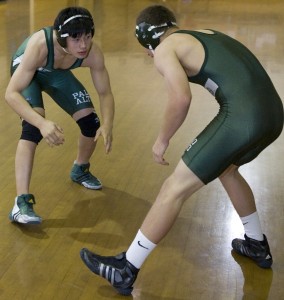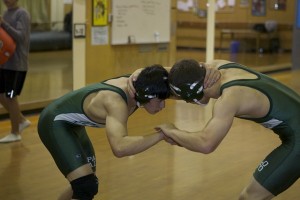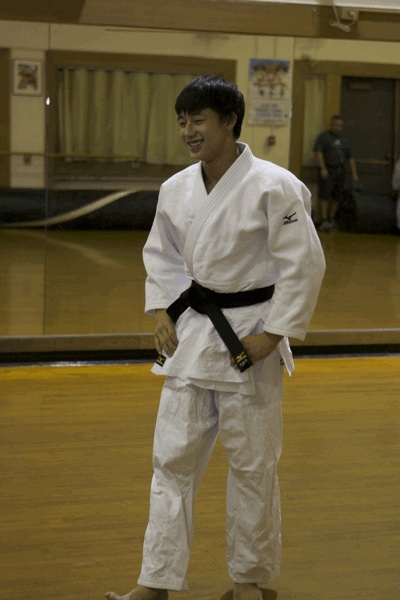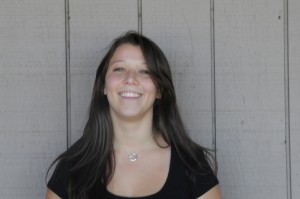In most sports, a competitor losing consciousness usually causes uproar. But in the sport judo, Ryan Oshima (’12) regularly hooks his arm under his opponent’s to knock him out.
Oshima, only a sophomore, excels in both wrestling and judo by blending moves from each of his sports into a unique style. Oshima joined the Palo Alto High School varsity wrestling team as a freshman after beating two upperclassmen for the spot. He now leads the team as a captain.
Judo, a Japanese martial art, has passed from generation to generation, starting with Oshima’s paternal grandfather.
“I was introduced to judo when I was 10 by my dad, around six and a half years ago,” Oshima said. “I think he introduced me because he wanted me to get involved in the sport that a lot of my family has become a part of. It’s really a family tradition.”
His father, Ryan Sr., also practiced judo in high school and college. He now passes the legacy on to his sons.
“I always tell my sons that judo takes a lifetime to learn, and that they should look forward to practicing, learning, and teaching judo, wherever and whenever they are in life,” Mr. Oshima said.
Mr. Oshima coaches his sons in competitive judo and has attended all of his judo and wrestling tournaments except for two.
“If [my dad] wasn’t my coach I wouldn’t get the in-depth analysis that he gives me,” Oshima said. “He helps me learn where to improve on.”
Oshima and his father critique recorded videos of every match. The critiques help Oshima understand where he needs to improve and what moves are successful.
“[Watching videos] is a very painful process, and is always a source of tension, but is one of the best tools to improve performance,” Mr. Oshima said. “Ryan is doing his own analysis now, and is even more critical of himself than I ever was.”
Oshima’s dad does not only help his son’s judo career, but also encourages his wrestling endeavors. Despite Mr. Oshima’s lack of wrestling knowledge prior to Oshima’s interest in the sport, he fully supports his son and his accomplishments.
“I have a very selfish reason for attending my sons’ competition. I love to watch them [My sons] compete,” Mr. Oshima said. “They compete [for] very few years of their lives, and if I don’t watch them now, the chance is lost forever.”
Oshima not only enjoys judo, but he has also had a very successful career since his start at age 10. In fifth grade, he began competing at tournaments. This past summer, Oshima received first place in two national tournaments and placed second in another.
“[The San Diego tournament] was small, only six guys in the bracket,” Oshima said. “[In] the other nationals, I got first, there were about 10 [competitors]. Judo brackets are usually smaller than most other sports because not as many people do the sport, but the level of competition is the same as other sport’s national competitions.”
As far as weighing in and other routines go, Oshima, a competition veteran, knows what to expect when he travels across the country.
“The whole process was pretty routine,” Oshima said. “I’ve been going to nationals for a few years, so it wasn’t anything new. The awards for nationals are really grand – big medals and a lot of people. It feels great to be on the podium.”
Mr. Oshima shares the feeling of accomplishment with Oshima after his breakthrough performances.
“Although these were great accomplishments, I was more pleased with the way he won, using a wide variety of throws, combinations and strategies,” Mr. Oshima said. “He is really maturing as a competitor.”
When Oshima returned home from tournaments, his coaches, family and friends congratulated him for his first place national finish. Although he had won first at a national tournament, Oshima did not notice much change in the way people treated him at practice. The win makes him the first person at his Stanford club to win a national tournament. Practicing at Stanford, with older and heavier competitors, has helped bring his judo to the national level.

At my old club [Palo Alto Judo Club], I wasn’t gaining the same type of practice because I was going against a lot younger kids,” Oshima said. “Now, at Stanford, everyone’s usually about 10 to 20 pounds heavier than me, but that helps me deal with stronger people. I think that’s what makes a good team – when everyone’s at the same level as each other and everyone really wants to learn and become better.”
Oshima’s successful judo career inspired him to begin wrestling in the sixth grade at Jordan Middle School. Since then, Oshima has incorporated many judo moves and throws into his repertoire of wrestling techniques.
“Judo has been a big part of my wrestling,” Oshima said. “I integrate it a lot. It helps me win a lot of matches, trying to come up with a good offense. [I plan to] keep on doing what I’m doing and integrate judo into my strategy with more things that people don’t expect, like a lot more throws and different combinations of throws.”
Not many opponents expect Oshima’s judo moves.
“He’s very good with balance and stance, and he’s very good at throwing people,” wrestling head coach David Duran said. “He’s very dangerous and the better wrestlers that have wrestled him know that already, and it kind of takes away some of their offense because they don’t want to get caught in a position to get thrown because he’ll throw you, and he’s good at it.”
As a freshman, Oshima beat older wrestlers with judo throws and other techniques. His coaches, seeing this strategy, had Oshima help his teammates master these moves as well.
On Gunn High School’s senior night last year, Oshima was set to wrestle a senior ranked in the top 10 Central Coast Section (CCS). Behind five points in the second period, Oshima saw the opportunity to pin his opponent by throwing him onto his back.
“He was wrestling a senior and he was losing the whole match until he got him into one of his throws and caught him on his back and pinned him,” wrestling teammate Joey Christopherson (’12) said.
The win helped boost the team’s morale for them to win the entire dual and beat rival Gunn.
“That was one of the big matches that helped turn that dual meet around, which we ended up winning,” Duran said.
Oshima not only beat many upperclassmen in such duals, but he also beat Paly wrestlers Chris Hood (’10) and Sean Keohane (’09) for his spot on varsity.
“Ryan moved up to varsity and nobody doubted the fact that he deserved it because of his judo background,” Keohane said. “He had a ton of previous experience with grappling, so when he got out on the mat you could tell he was a lot more composed than most wrestlers that had just as much experience as he did. Not to mention his throws were second to none.”

Injuries, weight fluctuations, and many other obstacles prevent a wrestler from remaining on varsity. Oshima’s opportunity came when Keohane tore his rib cartilage at the Reno Classic last year, which opened a spot on varsity.
“I was coming off a rib injury, so in order to win back my spot I had to go through Ryan, which is by no means an easy competitor,” Keohane said. “Unfortunately, I lost the challenge match, and I was torn. I’m not one to take losing easily and the loss pushed me to work harder, but unfortunately, time was not on my side.”
Oshima’s teammates and coaches see that judo assists his wrestling career. Judo also gives him the tools he needs to be successful, such as remaining calm and collected on the mat.
“There are many concepts in common and many of the instructions I hear from the wrestling coaches are exactly the same instructions I shout out in judo,” Mr. Oshima said. “I believe that as Ryan’s wrestling skills develop, his judo knowledge will be a great advantage.”
Oshima believes that judo helps his wrestling more than his wrestling helps his judo due to the differences between the sports.
“I don’t know what his first love is, judo or wrestling, but whatever it is, he’s good at both of them,” Duran said.
Although the two sports share similarities, they have many differences like scoring. In wrestling, the winner has to pin the opponent with his shoulder blades touching the mat for two seconds; if both wrestlers fail to pin the other, then the match is determined by a system of points. Points vary when a player takes his opponent down, escapes from a hold, reverses from underneath to gain control or nearly pins the other.
“You can either pin them for 25 seconds, get a choke until they pass out, arm bar until they pass out or you can throw them on their back with enough force,” Oshima said.
Along with two different scoring regulations comes two different techniques and approaches to judo and wrestling.
“Judo is more focused on throws, but there’s also chokes and arm-bars, whereas wrestling focuses on take downs,” Oshima said.
Since sports require a strong base in addition to a muscular build and athletic endurance, they have similar training.
“The two sports are really similar in that they are both contact sports where repetition in training and being [in top] physical shape is necessary to win,” Oshima said.
In the end, Oshima treats both judo and wrestling very similarly taking both sports to the top.
“He’s a really dedicated wrestler,” Christopherson said. “He does a lot of judo, and after our practices he goes to Stanford to do judo practice. He also does a lot of clinics for extra wrestling and does a lot of weight training.”
Oshima’s continuous participation on the mat and in the weight room makes him one of the most devoted players on the team. Duran made Oshima team captain due to his belief that dedication goes hand in hand with leadership.
“He has very strong leadership skills and a very strong work ethic,” Duran said. “He is a very good student. He is very quiet as far as his vocals compared to other captains that we’ve had, but he does lead by example. He’s the kind of kid that every coach would want to coach.”
As team captain, Oshima leads by example, always pushing himself during practice and tournaments. Oshima is encouraged by his coaches to teach and explain his judo moves to all wrestlers, regardless of age. He also motivates his fellow wrestlers during practice.
“He really knows what he’s doing and how to lead and show the underclassmen how they should act and what they need to do to be a good wrestler,” Christopherson said. “He has helped me by showing me what I need to do in order to be the best I can. He has shown me some of his judo moves and also how he has been a good wrestler and a good role model to the team.”
Oshima helps to create a healthy team atmosphere in the Paly weight room.
“[Oshima] is a very quiet kid for the most part, but it’s all one big family in there, a little different than the other sports because everybody goes through the same thing, even the kid who is brand new to the better kids,” Duran said. “Everyone goes through the same thing, but I think he’s finding out who he is a little more as a person, so the interaction between the kids is much better.”
Another reason Judo and wrestling are similar is that they are both individualistic sports that require less team chemistry and more individual motivation.
“It is similar in that they’re both individual sports because it is one versus one.But wrestling for Paly is really working for a team and you have that team bond and team chemistry,” Oshima said. “I think [working as a team] is better because you have different teammates that can help you push different things and it really makes you a lot better than being by yourself.”
Oshima dreams of placing in the state tournament by his senior year, and he hopes to once again qualify for CCS.
“I think he has put in the most work out of all of us and he has the most potential, and he could easily go to the state meet either next year or senior year,” Christopherson said.
Duran noted that many of Paly’s finest wrestlers have advanced to states. He believes that Oshima is capable of placing in CCS, and in states, in his next three years at Paly. Oshima feels undecided about whether to pursue wrestling or judo in college; he is reluctant to devote his entire life to either sport. But until then, Oshima will focus on this season of wrestling at Paly.




